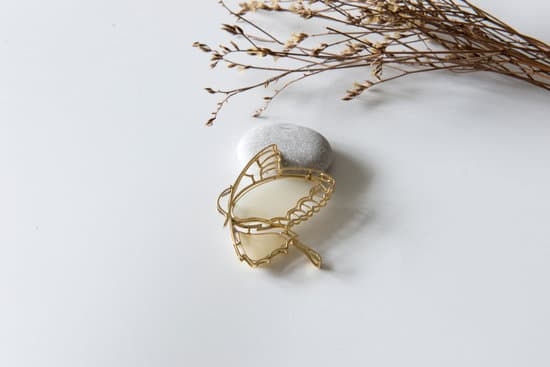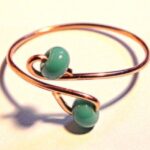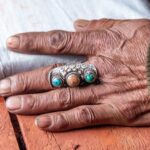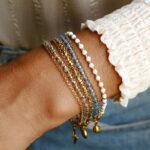Gold plated jewelry has become increasingly popular due to its affordability and glamorous appearance. However, many people are unsure about whether or not it is safe to wear this type of jewelry in the shower. In this article, we aim to address this common question and provide you with the information you need to make an informed decision.
Before diving into the specifics, it is important to understand what exactly gold plated jewelry is. Unlike solid gold or gold-filled jewelry, gold plated pieces consist of a base metal coated with a thin layer of gold through electroplating. This process gives the jewelry its signature golden look, but it also affects its durability and resistance to water and other elements.
The composition and thickness of the gold plating play a crucial role in determining how well the jewelry will hold up against exposure to water. Water can cause oxidation and tarnishing in gold plated jewelry, especially if substandard quality materials are used during plating or if soap, chemicals, chlorine, or extreme temperatures are involved.
In the following sections, we will explore these factors in more detail and discuss practical tips for showering with gold plated jewelry while minimizing potential damage. So let’s dive deeper into the fascinating world of gold plated jewelry and get all your questions answered.
Understanding the concept of gold plated jewelry
Gold plated jewelry is a popular choice for many individuals due to its affordability and aesthetic appeal. However, there is often confusion surrounding the question of whether or not it is safe to shower with gold plated jewelry. In order to understand the answer to this question, it is important to first understand the concept of gold plating and how it differs from other types of jewelry.
Gold plated jewelry is created by applying a thin layer of gold onto a base metal through a process known as electroplating. This results in a piece of jewelry that has the appearance of solid gold but is actually made primarily of another metal such as brass or copper. It should be noted that gold plating is different from solid gold or gold-filled jewelry, which contain a much higher percentage of actual gold.
The process of gold plating impacts the overall durability and longevity of the jewelry. The thickness of the gold layer applied during the plating process can vary, with higher quality pieces typically having a thicker layer. Thicker layers provide greater protection against wear and tear, as well as exposure to elements such as water. Additionally, some gold plated jewelry may receive an additional protective coating to further enhance its resistance to moisture.
While it may be tempting to wear your gold plated jewelry in the shower, it is important to consider how water can affect its condition. Water itself does not damage gold plated jewelry, but prolonged exposure can cause issues over time.
Factors such as temperature, soap, chemicals, and chlorine can accelerate tarnishing and oxidation on the surface of the piece. If you choose to shower with your gold plated jewelry, it is important to take steps to minimize potential damage by removing them when using soaps or highly chlorinated water.
The composition of gold plated jewelry
The base metal used in gold plated jewelry
Gold plated jewelry consists of a base metal that is coated with a layer of gold. The base metal can vary depending on the manufacturer, but common options include copper, brass, silver, or stainless steel. The choice of base metal plays a significant role in determining the durability and resistance of the gold plating to water and other elements.
Copper is often used as a base metal due to its affordability and ability to facilitate efficient bonding with the gold layer. However, it is important to note that copper can react with water and oxygen over time, leading to tarnishing and discoloration.
On the other hand, stainless steel or silver are more resistant to these effects but may be costlier options. It is advisable to research and choose a reputable jeweler who uses high-quality base metals for their gold plated jewelry.
The impact of thickness on longevity
The thickness of the gold plating also affects the longevity of gold plated jewelry when exposed to water. Generally, thicker layers of gold offer better durability and resistance compared to thin ones. A thicker layer ensures that the base metal beneath remains protected for a longer period.
It is crucial to consider the micron count when purchasing gold plated jewelry. Micron refers to the thickness measurement unit for gold plating, where one micron is equal to 1/1000th millimeter. Higher microns indicate a thicker layer of gold plating. Jewelry with higher micron counts tends to have greater longevity and resilience against exposure to water.
When wearing your gold plated jewelry in the shower, keep in mind that exposure to soap or chemicals can erode away thin layers more quickly than if you were wearing it in non-water environments like dry land activities.
Understanding limitations and trade-offs
While it may be tempting to wear your favorite golden necklace or bracelet in the shower, it is essential to understand the limitations and trade-offs of doing so. The gold plating on jewelry is not as durable or long-lasting as solid gold or gold-filled jewelry, which means it requires extra care and caution to maintain its appearance.
Exposure to water, soap, chemicals, and chlorine can expedite the wear and tear process of gold plated jewelry. It may cause the gold layer to fade or chip away more quickly, revealing the base metal beneath.
Therefore, it is important to assess your lifestyle and daily activities before deciding whether or not to wear your gold plated jewelry in the shower. If you engage in activities that involve frequent contact with water or potential rough handling of jewelry, it might be more advisable to remove your gold plated pieces before showering.
The effects of water on gold plated jewelry
The effects of water on gold plated jewelry can vary depending on various factors such as the quality of the plating, the thickness of the gold layer, and the individual’s daily activities. While it is generally not recommended to shower with gold plated jewelry, there are certain risks and considerations to keep in mind.
One potential risk of exposing gold plated jewelry to water is oxidation. When gold-plated jewelry comes into contact with water, it can cause a chemical reaction that leads to oxidation or discoloration of the metal. This can result in a dull appearance or even blackening of the jewelry over time. Additionally, if the gold plating begins to wear off due to frequent exposure to water, it can expose the base metal underneath, further increasing the risk of tarnishing.
The role of water-related factors such as temperature, soap, chemicals, and chlorine should also be considered when evaluating whether or not to shower with gold plated jewelry. Hot water and steam can cause metals to expand and contract, which may weaken or damage the delicate layer of gold plating over time.
Soap and chemicals present in shampoos, conditioners, body washes, and other shower products can also contribute to color fading and deterioration of the plating. Similarly, swimming pools and hot tubs containing chlorine can have a corrosive effect on gold plated jewelry.
To minimize potential damage while wearing gold plated jewelry in the shower, there are several tips that can be followed. Firstly, it is advisable to limit exposure by keeping showers short and avoiding excessive amounts of soap or chemicals on the jewelry.
Wiping down the jewelry with a soft cloth after showering can help remove any residue that may have accumulated. It is also important to store gold plated jewelry properly when not in use to prevent scratching or tangling with other pieces.
Although there are ways to mitigate damage while showering with gold plated jewelry, it is still recommended to remove it before entering any water. By doing so, individuals can ensure the longevity and durability of their gold plated jewelry without taking unnecessary risks.
Factors to consider before wearing gold plated jewelry in the shower
Before deciding whether or not to wear your gold plated jewelry in the shower, it is important to consider several factors. These factors will help you determine the potential risks and make an informed decision. Here are some key factors to consider:
- Quality of the gold plating: The quality of the gold plating on your jewelry plays a significant role in its resistance to water and other elements. If the gold plating is of poor quality, it may easily wear off or tarnish when exposed to water. To ensure durability, opt for high-quality gold plated jewelry that has been properly processed and coated with a thick layer of gold.
- Daily activities: Consider your daily activities before wearing gold plated jewelry in the shower. If you lead an active lifestyle or engage in activities that involve excessive sweating or exposure to chemicals, it may be best to remove your jewelry before showering. Sweat can accelerate corrosion and tarnishing, while direct contact with chemicals can cause damage to the gold plating.
- Skin sensitivity: Some individuals have sensitive skin that can react negatively to prolonged contact with water and metals. If you have sensitive skin, it is advisable to remove your gold plated jewelry before showering to minimize any potential irritation or allergic reactions.
If you decide that it is safe for you to wear your gold plated jewelry in the shower based on these factors, here are some tips for minimizing potential damage:
- Limit exposure: Try to keep your showers short and avoid unnecessarily wetting your jewelry.
- Avoid harsh soaps and chemicals: Certain soaps and cleaning products can be harsh on delicate materials like gold plating. Opt for mild soaps and avoid using chemical-based products while wearing your gold plated jewelry in the shower.
- Pat dry gently: After showering, gently pat dry your jewelry using a soft cloth to remove any excess moisture.
- Store properly: When not in use, store your gold plated jewelry in a dry and safe place to prevent exposure to moisture and other elements.
While it is generally recommended to remove gold plated jewelry before showering to ensure its longevity, everyone’s situation may differ. Make sure to consider the quality of your jewelry and these factors before making a decision. Ultimately, it is important to prioritize the care and maintenance of your gold plated jewelry to keep it looking its best for as long as possible.
Tips for showering with gold plated jewelry
When it comes to showering with gold plated jewelry, there are several tips that can help minimize potential damage and keep your jewelry looking its best. By following these guidelines, you can enjoy wearing your gold plated pieces in the shower while extending their longevity.
Minimize exposure to water
To minimize the risk of damage, it is important to limit the amount of time your gold plated jewelry spends in contact with water. Try to keep your showers short and avoid activities like swimming or bathing in hot tubs while wearing your jewelry. Additionally, be mindful of the water temperature, as extremely hot water can speed up tarnishing and oxidation processes.
Avoid harsh chemicals and soaps
Certain chemicals found in soaps, shampoos, and body washes can cause harm to gold plated jewelry by corroding the metal underneath the plating. To protect your jewelry, choose mild and gentle products that are free from harsh chemicals. It is also advisable to remove your gold plated jewelry before using cleaning agents or applying skincare products.
Pat dry and store properly
After showering, gently pat dry your gold plated jewelry using a soft cloth to remove any moisture on the surface. Avoid rubbing or scrubbing vigorously, as this can cause scratches or wear down the plating over time. Once dry, store your jewelry in a clean and dry place, preferably in a separate pouch or compartment to prevent it from coming into contact with other items that may scratch or damage it.
Regular maintenance
Regular maintenance is crucial for preserving the appearance of your gold plated jewelry. Follow the manufacturer’s instructions for cleaning and care recommendations specific to your piece. Generally, avoid using abrasive cleaners or polishing cloths that could strip away the delicate plating layer.
It is important to note that while these tips can help minimize damage, it is ultimately up to personal preference and the quality of your gold plated jewelry whether or not you should shower with it. It is always a good idea to evaluate the quality of the gold plating, including its thickness and resistance to water, before deciding whether or not to wear your jewelry in the shower.
Additionally, consider factors such as daily activities, skin sensitivity, and exposure to other external elements that may affect the longevity of your gold plated jewelry.
Ultimately, making informed decisions and taking proper care of your gold plated jewelry will help ensure that it stays beautiful and shiny for as long as possible.
Alternatives to showering with gold plated jewelry
Gold plated jewelry can add a touch of luxury and elegance to any outfit, but when it comes to showering with this type of jewelry, there are some factors to consider. While it is generally not recommended to wear gold plated jewelry in the shower, there are alternatives that can help you incorporate your favorite pieces into your daily routine without risking damage.
One alternative to wearing gold plated jewelry in the shower is to simply remove it before getting in. Whether you choose to place your jewelry on a safe surface in your bathroom or store it securely in a jewelry box, taking off your gold plated pieces before showering can minimize exposure to water and potential damage.
If you prefer to wear jewelry at all times, another option is to rotate between different pieces. By wearing other types of jewelry during showers or other activities where exposure to water is likely, you can protect your gold plated pieces and ensure their longevity.
Another alternative is investing in waterproof seals or coatings for your gold plated jewelry. These specialized products create a protective barrier that helps prevent water from reaching the base metal and causing damage. While these sealants may require regular reapplication, they can be an effective way to keep your gold plated jewelry safe while still enjoying the convenience of wearing it in the shower.
It’s important to note that not all gold plating is created equal, so the effectiveness of these alternatives may vary depending on the quality of the plating and the specific piece of jewelry. It’s always a good idea to consult with a jeweler or refer to the manufacturer’s guidelines for care and maintenance instructions for your particular piece of gold plated jewelry.
Overall, while it is generally not recommended to wear gold plated jewelry in the shower, there are alternatives available for those who want to incorporate their favorite pieces into their daily routine without risking damage. Whether you choose to remove your jewelry before showering or invest in protective coatings, taking proper care and maintenance measures will help extend the life of your gold plated jewelry and keep it looking beautiful for years to come.
| Alternatives to showering with gold plated jewelry |
|---|
| – Remove jewelry before showering |
| – Rotate between different pieces |
| – Invest in waterproof seals or coatings |
Final verdict
The final verdict on whether or not it is safe to shower with gold plated jewelry depends on several factors.
First and foremost, the quality of the gold plating plays a significant role. Higher quality gold plated jewelry tends to have a more durable coating that is less likely to wear off or tarnish when exposed to water. A thicker layer of gold plating can also provide better protection against moisture and prevent the underlying base metal from coming into contact with water.
Another important consideration is your daily activities and lifestyle. If you lead an active lifestyle or engage in activities that involve prolonged exposure to water, such as swimming or exercising, it may be best to remove your gold plated jewelry before engaging in these activities. This will help minimize the risk of damage due to constant exposure to water and other elements.
Additionally, individual factors such as skin sensitivity and allergies should also be taken into account. Some people may experience skin reactions or discoloration when wearing gold plated jewelry in the shower, especially if they have sensitive skin. In such cases, it is advisable to remove the jewelry before showering to avoid any potential discomfort or adverse reactions.
| Factors | Considerations |
|---|---|
| Quality of Gold Plating | Durable coating and thickness |
| Daily Activities | Prolonged exposure to water and activities |
| Skin Sensitivity | Potential skin reactions or allergies |
Conclusion
In conclusion, the question of whether or not it is safe to shower with gold plated jewelry has been thoroughly explored in this article. By understanding the concept and composition of gold plated jewelry, as well as the effects of water on it, readers are equipped with the knowledge needed to make an informed decision.
While some risks are associated with showering while wearing gold plated jewelry, such as oxidation and tarnishing, there are also factors to consider before making a decision. These include evaluating the quality of the gold plating and its resistance to water, considering daily activities and exposure to external elements, as well as individual skin sensitivity.
For those who choose to wear their gold plated jewelry in the shower, there are practical tips provided in this article that can help minimize potential damage. However, for those who prefer not to take any risks with their jewelry, removing it before showering is suggested.
Ultimately, readers are encouraged to make decisions based on their personal preferences and the quality of their gold plated jewelry. Regardless of whether or not they choose to wear their jewelry in the shower, proper care and maintenance are emphasized as crucial for extending its life. By following proper care routines, individuals can continue enjoying their gold plated jewelry for longer periods of time.
Frequently Asked Questions
Can you get gold plated jewelry wet?
Gold plated jewelry can typically withstand some exposure to water without getting damaged. However, excessive exposure to water, especially if it contains harsh chemicals or chlorine, can potentially cause the gold layer to wear off more quickly.
It is advisable to remove gold plated jewelry before activities such as swimming, showering, or participating in water sports to prolong its lifespan. Additionally, it is important to dry the jewelry thoroughly after being exposed to water to prevent any potential tarnishing or damage.
How long does gold plated jewelry last?
The durability and longevity of gold plated jewelry depend on various factors such as the quality of the plating and how well it is taken care of. Generally, gold plated jewelry tends to last for a couple of years before fading or wearing off.
However, with proper maintenance and care, it is possible for gold plated jewelry to retain its appearance for longer periods. It’s important to avoid exposing it to moisture, chemicals (such as perfumes or lotions), and rough surfaces that may cause scratches or abrasions.
Is it OK to sleep with gold plated jewelry?
While it may be tempting to sleep with your gold plated jewelry on since it enhances your overall look and saves time on removing/reapplying accessories daily, it is generally recommended not to sleep with it on. When you move during sleep, there’s a higher risk of snagging the delicate chain or damaging delicate parts of the piece accidentally.
Moreover, sweat produced during sleep can expedite the wear-off process of the gold plating due to increased moisture contact. To maintain its longevity and minimize chances of damage or discoloration, taking off your gold plated jewelry before sleeping is advised.

Welcome to my jewelry blog! My name is Sarah and I am the owner of this blog.
I love making jewelry and sharing my creations with others.
So whether you’re someone who loves wearing jewelry yourself or simply enjoys learning about it, be sure to check out my blog for insightful posts on everything related to this exciting topic!





